
I have always been a big proponent of filtered (or dry stack) tailings over conventional tailings disposal. Several years ago I had written a blog (Fluid Tailings – Time to Kick The Habit?) that this is the tailings disposal approach the mining industry should be moving toward.
 Recently I have been seeing more mining studies proposing to use the dry stack approach. In some cases, they no longer even do the typical tailings trade-off study that look at different options. The decision is made upfront that dry stack is the preferred route due to its environmental acceptability and positive perceptions.
Recently I have been seeing more mining studies proposing to use the dry stack approach. In some cases, they no longer even do the typical tailings trade-off study that look at different options. The decision is made upfront that dry stack is the preferred route due to its environmental acceptability and positive perceptions.
Recently I came across a nice document prepared by BHP and Rio Tinto titled “Filtered Stacked Tailings – A Guide for Study Managers (March 2024)”. I will refer to this document as “The Guide”. You should definitely get a copy of this Guide if your project is considering a dry stack operation. An information link is included at the end of this post.
A Guide for Study Managers
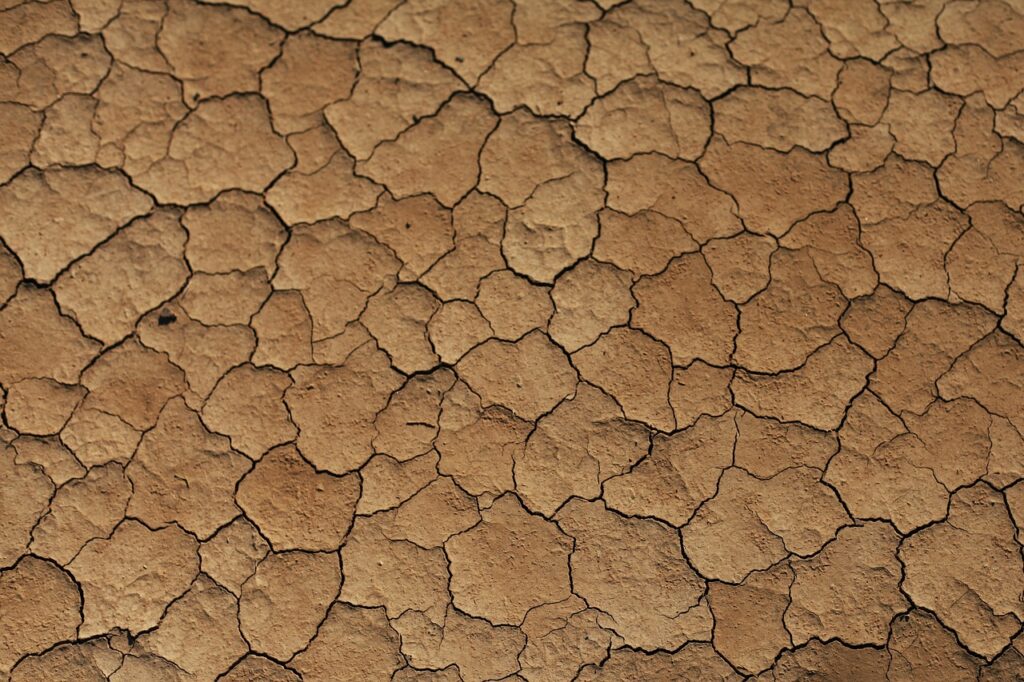 The Guide covers several topics, including tailings characterization; site closure concepts; filtered tailings stack design; material transport, stacking systems; and tailings dewatering methods. The Guide covers all the basics very well. The one area that jumped out at me is the tailings characterization and testing aspect.
The Guide covers several topics, including tailings characterization; site closure concepts; filtered tailings stack design; material transport, stacking systems; and tailings dewatering methods. The Guide covers all the basics very well. The one area that jumped out at me is the tailings characterization and testing aspect.
Many assume that dry stack is simply filter, haul, dump, then walkaway. Its all very easy! However, in reality, the entire dry stack approach is complex.
One needs to be able to consistently dewater tailings from different ore types, then transport it under different climatic conditions, and then place and compact the tailings efficiently.
One also needs to be able to deal with plant upsets, when the filtered tailings don’t meet the optimal product specifications. So its not really that simple.
One of the chapters in the Guide details the different test work that should be done to understand the dry stack approach. The list of tests is a lot longer than I had envisioned. I previously knew some of the types of lab testing required, however the Guide outlines a very comprehensive list.
The Guide also categorizes the tests according to study stage, be it concept study, order of magnitude study, or Pre-Feasibility level. Interestingly, the concept study can rely mainly on published information. However, the more advanced mining studies require the lab testing of actual tailings material.
Testing Checklist
To help organize the complexity of testing, I have listed their suggested tests as to whether the test is related to material characterization, process characterization, or filtered product characterization. Each aspect serves a different purpose in understanding the workings of the filtered tailings approach. The engineer will decide at which study stage they wish to do each of the tests, or which of the them they actually need to do.
To keep the blog post brief, I am not describing the details for each test. Most geotechnical or process engineers will already be familiar with them, or anyone can search the web to learn more.
MATERIAL CHARACTERIZATION TESTS
-
Chemical composition Testing: using atomic absorption or spectroscopy, identify the elements within the tailings stream to highlight contaminants and potential flocculation issues.
-
Conductivity Test: increase knowledge of the tailings stream.
-
Mineralogy Testing: identify mineral types and clay minerals (if any) that could impact on performance.
-
Particle Shape Analysis: are there fibrous minerals present, as well as settling and rheology effects.
-
Particle Size Distribution: are the tailings coarse, or mainly fine silt and clay sized particles that can impact on filtering and product performance.
-
pH Test: determine the acidity of the tailings steam, can relate to flocculant selection.
-
Tailings Slurry Density Test: assess the pumpability and amount of thickening and filtering that will be required.
-
Tailings Solid Mass Concentration and Moisture content: required for process mass balances.
-
Specific Gravity Testing: assess the SG of the tailing particles, i.e. light or heavy minerals.
-
Total Dissolved Solids Test: assess the fluid composition, are minerals dissolvable.
-
Zero Free Water Test: relates to the solids concentration at which the sample is fully saturated and may relate to transportability.
PROCESS CHARACTERIZATION TESTS
-
Total Suspended Solids: assess the quality of the return water from thickening or filtration.
-
Drained and Undrained Settling Test: to assess the thickening aspects and stack performance.
-
Setting Cylinder Tests: used to assess thickener settling performance.
-
Raked Setting Cylinder Tests: used to assess thickener settling performance.
-
Dynamic Continuous Settling Tests: used to assess thickening under continuous feed situation.
-
Minimum Moisture Content: assess the minimum moisture content achievable in filtration.
-
Vacuum/Pressure Filtration Test: often done by vendors, assess the filtering performance.
-
Compression Rheology: design consolidation / permeability data for filtering and disposal design.
-
Shear Rheology: provide information for pump and pipeline design.
-
Shear Yield Stress: provide processing insights for slurry dispersion and flocculation.
FILTERED PRODUCT CHARACTERIZATION TESTS
-
Leaching Tests (long term): assess whether the tailings stack will continue to leach metals and contaminants over the long term.
-
Leaching Tests (short term): assess whether the tailings stack will rapidly leach metals and contaminants.
-
Acid Base Accounting Tests: will the stack be an ARD concern.
-
Net Acid Generation: relates to ARD and neutralizing potential.
-
Air Drying Tests: determine the rate of natural air drying and dry density.
-
Atterberg Limits Testing: determine the plastic limit, liquid limit with respect to moisture content and stackability.
-
Consolidation Tests (one-dimensional): to assess the consolidation and settlement of the stack over time.
-
Proctor Density Tests: assess the optimal compacted density and moisture content vs the moisture content delivered by filtration.
-
Critical Void Ratio Tests: assess compaction, consolidation, and liquefaction potential.
-
Shear Testing: determine the geotechnical strength of the filtered product for stack height design.
-
Permeability Testing: assess the internal drainage characteristics of the filtered product.
-
Soil-water characteristics Tests: assess the unsaturated behavior of the filtered product.
-
Flow Moisture Point Tests: assess how well the material can be transported and placed.
-
Conveyance Testing: assess how well the material can be conveyed (troughing, steepness).
-
Minimum Angle for Discharge: used in the design of hoppers and chutes.
-
Angle of Repose Tests: used in hopper design and dry stack design. Ground Bearing Pressure: used to assess the trafficability of the deposit.
Conclusion
A dry stack operation might be just as complex as conventional tailings disposal, although that might not be the perception. Certainly, the processing side of filtered tailings is more complex than conventional tailings. The transportation design may also be more complex, as is the tailings placement methodology. The main complexity missing from the dry stack is the need for a large sludge retaining dam, albeit that is a huge and important difference.
Some might view the suggested testing checklist as overkill and decide that not all test work is necessary. That is most likely true for some situations, especially for small mines not dealing with large quantities of tailings. However for a project with a high capital investment, one doesn’t want to see the entire mill off-line because the tailings disposal system isn’t functioning.
 Major miners, such as BHP and Rio Tinto, typically spare no expense on material testing for metallurgical or geotechnical purposes. They have the funds available to test and engineer to a high level to adequately de-risk the project to meet their investment thresholds.
Major miners, such as BHP and Rio Tinto, typically spare no expense on material testing for metallurgical or geotechnical purposes. They have the funds available to test and engineer to a high level to adequately de-risk the project to meet their investment thresholds.
Junior miners often don’t have the time or funds to spend on such comprehensive testing programs. “Good enough” is often good enough.
One reason why junior miners sign 5-year JV deals with the Major is the amount of technical work required to properly evaluate a project.
The Major understands the amount of time needed for sample collection, testing, analysis of results, and follow up with more testing. It takes a fair bit of time to reach a comfort level for moving forward. Even then, there are no guarantees of success.
Each tailings disposal project is unique in size, location, type of mineralization, site layout, and throughput rate, so each company must decide what level of testing is “good enough” to address their risk tolerance.
For those that would like to get a copy of the the Guide, you can find more information at this LinkedIn link. I thank BHP and Rio Tinto for putting their heads (and wallets) together to prepare (and share) this document.










 If an engineer understands that a Mine Builder’s project will move from PEA to PFS to FS in rapid succession, then there is more incentive to ensure each study is somewhat integrated.
If an engineer understands that a Mine Builder’s project will move from PEA to PFS to FS in rapid succession, then there is more incentive to ensure each study is somewhat integrated. The objective of the Mine Vendor is to make the project attractive to potential buyers. There is less urgency in fast tracking detailed engineering and permitting.
The objective of the Mine Vendor is to make the project attractive to potential buyers. There is less urgency in fast tracking detailed engineering and permitting. As an engineer, it is helpful to understand the objectives of the project owner and then tailor the technical studies to meet those objectives. This does not mean low balling costs to make the study a promotional tool. It means focusing on what is important. It means recognizing the path, and what doesn’t need to be engineered in detail at this time. This may save the client time, money, and improve credibility in the long run.
As an engineer, it is helpful to understand the objectives of the project owner and then tailor the technical studies to meet those objectives. This does not mean low balling costs to make the study a promotional tool. It means focusing on what is important. It means recognizing the path, and what doesn’t need to be engineered in detail at this time. This may save the client time, money, and improve credibility in the long run. This post is just a brief discussion of mining project timelines. For those interested, there a few additional project timelines for curiosity purposes. Each path is unique because no two mining projects are the same. You can find these examples at this link “
This post is just a brief discussion of mining project timelines. For those interested, there a few additional project timelines for curiosity purposes. Each path is unique because no two mining projects are the same. You can find these examples at this link “
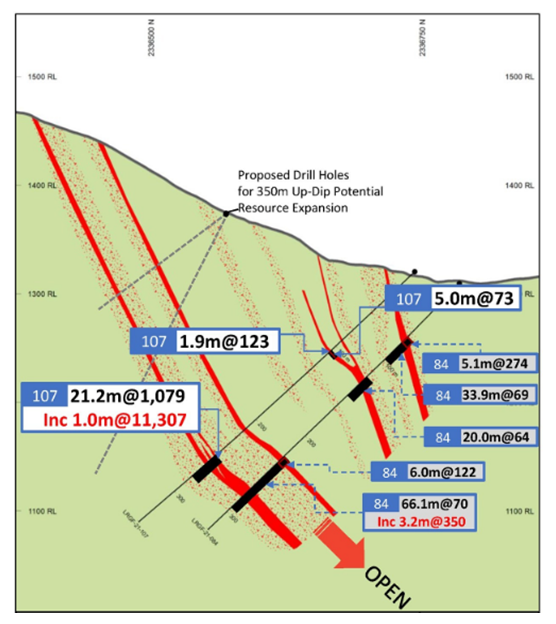 This article is about the benefit of preparing (cutting) more geological cross-sections and the value they bring.
This article is about the benefit of preparing (cutting) more geological cross-sections and the value they bring.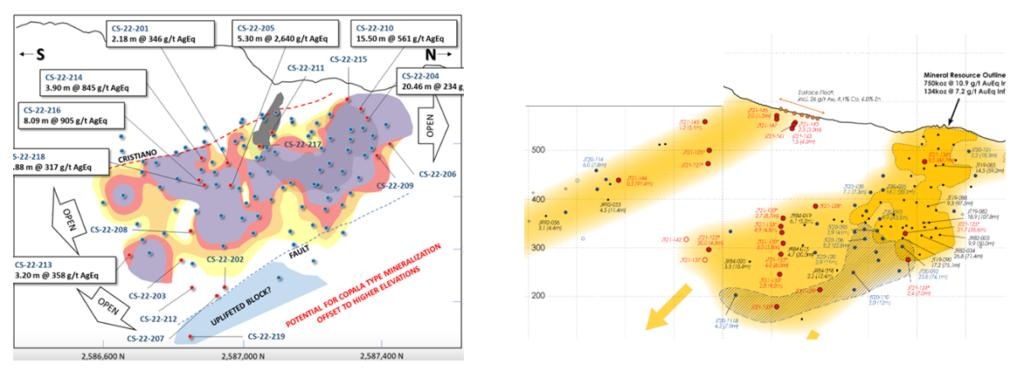 Long sections are aligned along the long axis of the deposit. They can be vertically oriented, although sometimes they may be tilted to follow the dip angle of an ore zone.
Long sections are aligned along the long axis of the deposit. They can be vertically oriented, although sometimes they may be tilted to follow the dip angle of an ore zone.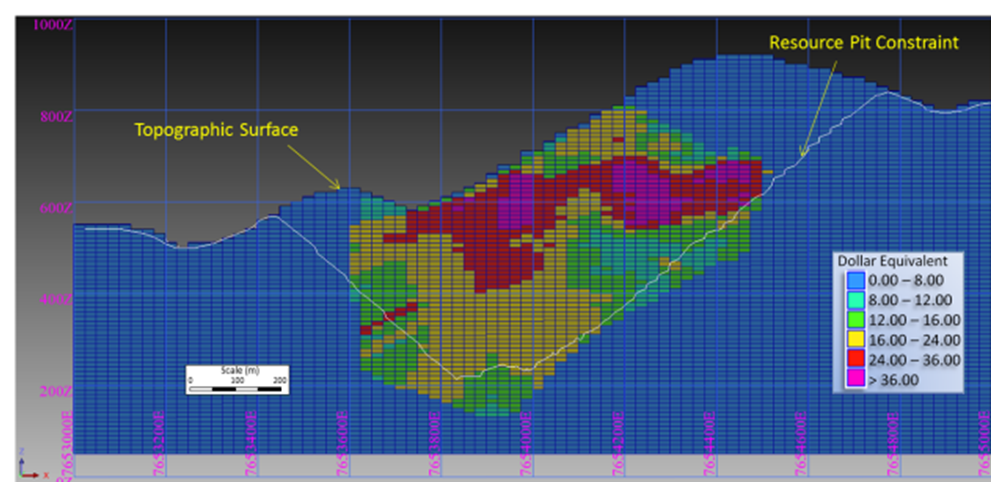 Cross-sections are generally the most popular geological sections seen in presentations. These are vertical slices aligned perpendicular to the strike of the orebody. They can show the ore zone interpretation, drill holes traces, assays, rock types, and/or color-coded resource block grades.
Cross-sections are generally the most popular geological sections seen in presentations. These are vertical slices aligned perpendicular to the strike of the orebody. They can show the ore zone interpretation, drill holes traces, assays, rock types, and/or color-coded resource block grades.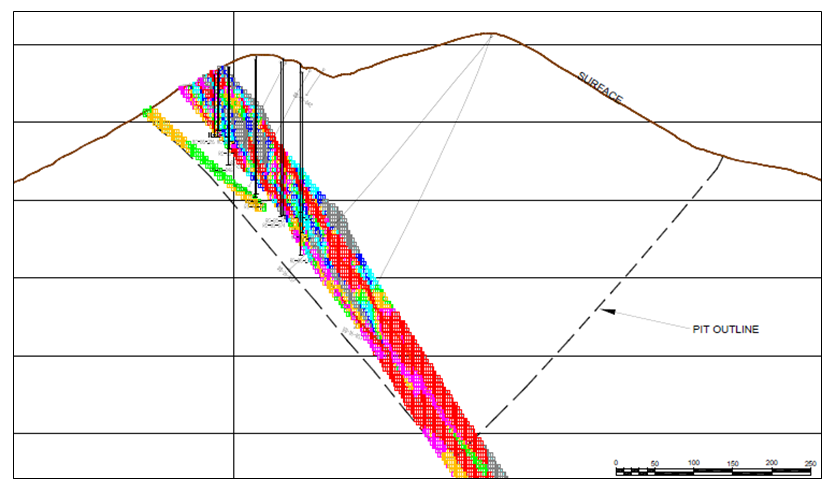 When looking at cross-sections, it is always important to look at multiple cross-sections across the orebody. Too often in reports one may be presented with the widest and juiciest ore zone, as if that was typical for the entire orebody. It likely is not typical.
When looking at cross-sections, it is always important to look at multiple cross-sections across the orebody. Too often in reports one may be presented with the widest and juiciest ore zone, as if that was typical for the entire orebody. It likely is not typical. Bench plans (or level plans) are horizontal slices across the ore body at various elevations. In these sections one is looking down on the orebody from above.
Bench plans (or level plans) are horizontal slices across the ore body at various elevations. In these sections one is looking down on the orebody from above. 3D PDF files can be created by some of the geological software packages. They can export specific data of interest; for example topography, ore zone wireframes, underground workings, and block model information. These 3D files allows anyone to rotate an image, zoom in as needed and turn layers off and on.
3D PDF files can be created by some of the geological software packages. They can export specific data of interest; for example topography, ore zone wireframes, underground workings, and block model information. These 3D files allows anyone to rotate an image, zoom in as needed and turn layers off and on.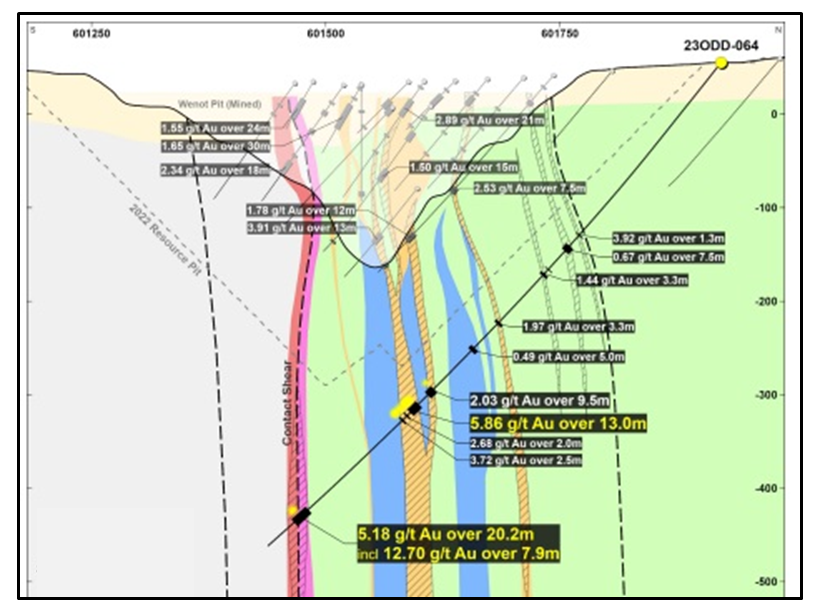 The different types of geological sections all provide useful information. Don’t focus only on cross-sections, and don’t focus only on one typical section. Create more sections at different orientations to help everyone understand better.
The different types of geological sections all provide useful information. Don’t focus only on cross-sections, and don’t focus only on one typical section. Create more sections at different orientations to help everyone understand better.
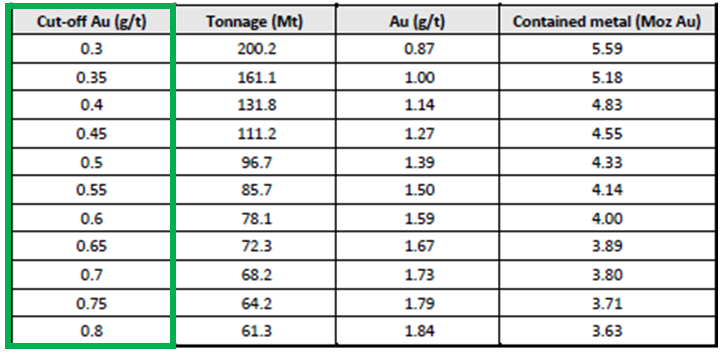
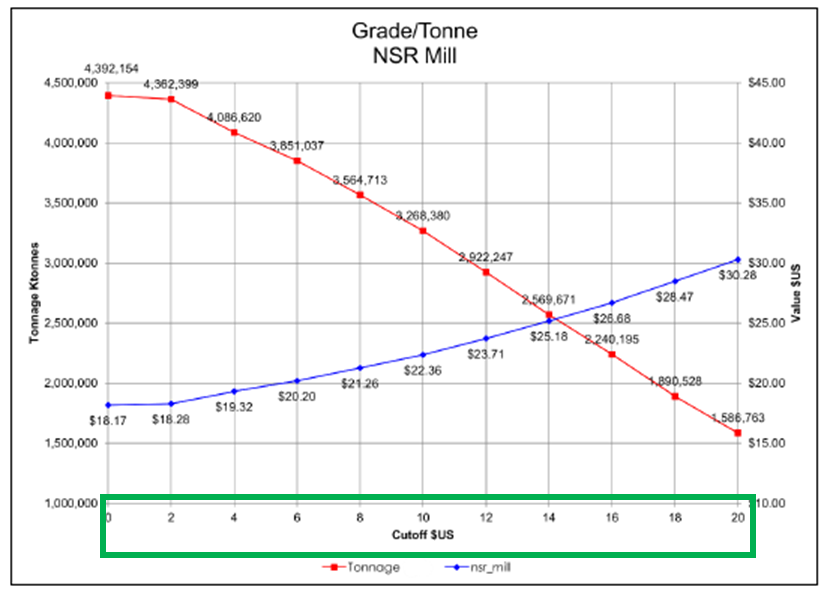
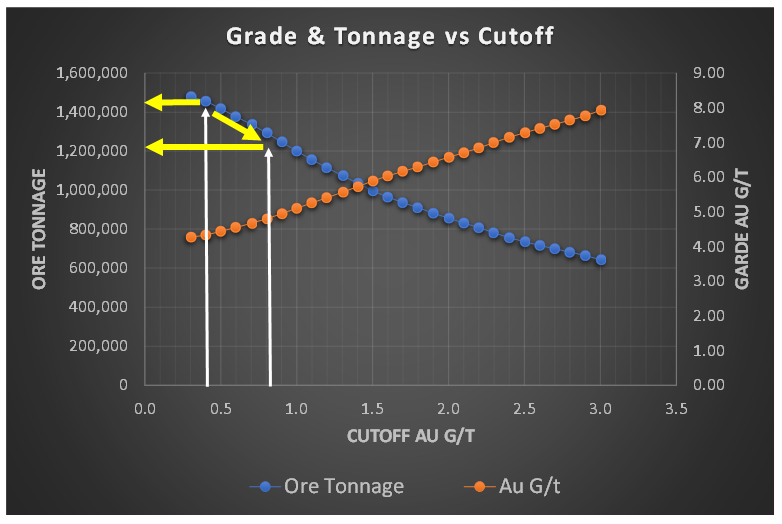 When I am undertaking a due diligence review or working on a study, very early on I like to have a look at the grade-tonnage information. This could be for the entire deposit resource, within a resource constraining shell, or in the pit design.
When I am undertaking a due diligence review or working on a study, very early on I like to have a look at the grade-tonnage information. This could be for the entire deposit resource, within a resource constraining shell, or in the pit design.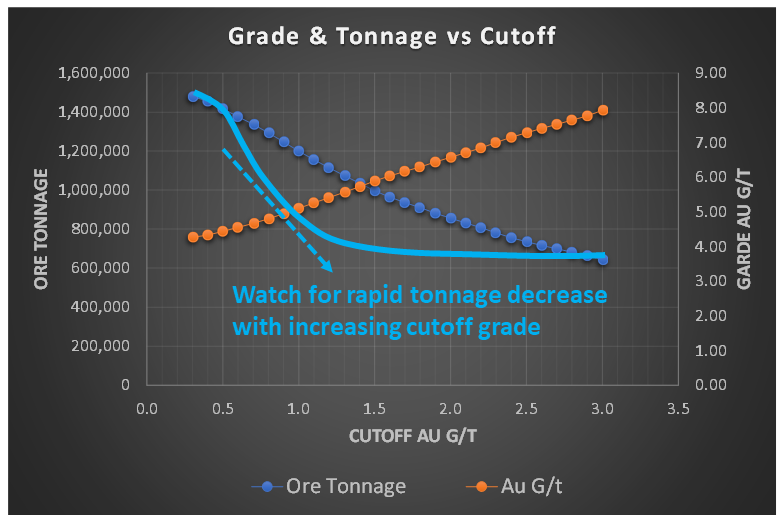 However, if the tonnage curve profile resembled the light blue line in this image, with a concave shape, the ore tonnage is decreasing rapidly with increasing cutoff grade. This is generally not a favorable situation.
However, if the tonnage curve profile resembled the light blue line in this image, with a concave shape, the ore tonnage is decreasing rapidly with increasing cutoff grade. This is generally not a favorable situation. One complaint I have about reporting mineral resources inside a resource constraining shell is the lack of strip ratio information. This applies whether disclosing a single mineral resource estimate or variable grade-tonnage data.
One complaint I have about reporting mineral resources inside a resource constraining shell is the lack of strip ratio information. This applies whether disclosing a single mineral resource estimate or variable grade-tonnage data.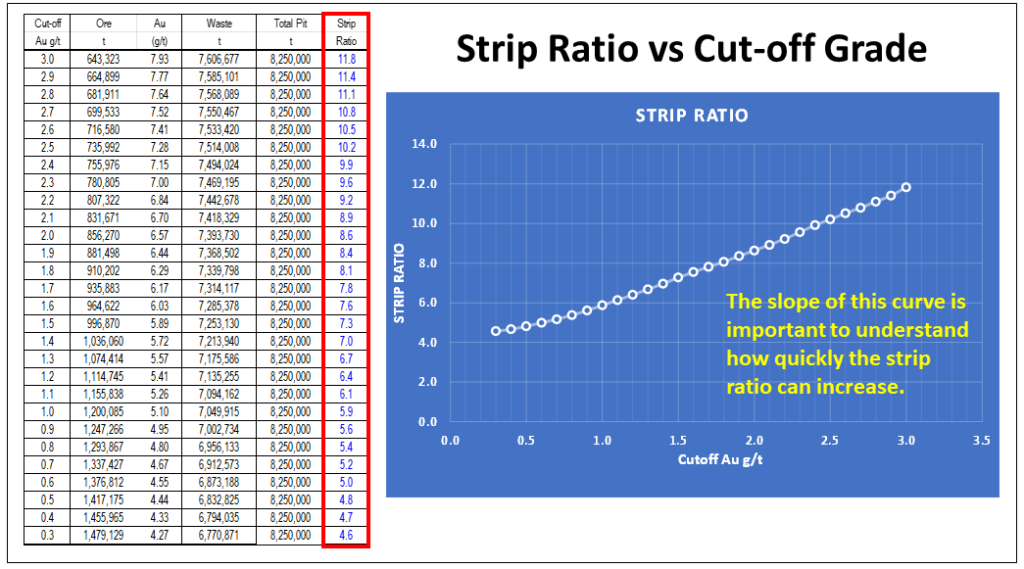 Regarding mineral resources, one should be required to disclose the waste tonnage and strip ratio when reporting resources inside a constraining shell. The constraining shell and cutoff grade are both based on defined economic factors such as unit mining costs, processing cost, process recoveries, and metal prices. With respect to the mining cost component, the strip ratio is a key aspect of the total mining cost, yet it normally isn’t disclosed.
Regarding mineral resources, one should be required to disclose the waste tonnage and strip ratio when reporting resources inside a constraining shell. The constraining shell and cutoff grade are both based on defined economic factors such as unit mining costs, processing cost, process recoveries, and metal prices. With respect to the mining cost component, the strip ratio is a key aspect of the total mining cost, yet it normally isn’t disclosed. In 43-101 technical reports, the financial Chapter 22 normally presents the project sensitivities expressed in a spider diagram or a table format.
In 43-101 technical reports, the financial Chapter 22 normally presents the project sensitivities expressed in a spider diagram or a table format.
 The primary question to be answered is whether one can mine safely and economically without creating significant impacts on the environment.
The primary question to be answered is whether one can mine safely and economically without creating significant impacts on the environment. Lake Turbidity: Dike construction will need to be done through the water column. Works such as dredging or dumping rock fill will create sediment plumes that can extend far beyond the dike. Is the area particularly sensitive to such turbidity disturbances, is there water current flow to carry away sediments?
Lake Turbidity: Dike construction will need to be done through the water column. Works such as dredging or dumping rock fill will create sediment plumes that can extend far beyond the dike. Is the area particularly sensitive to such turbidity disturbances, is there water current flow to carry away sediments?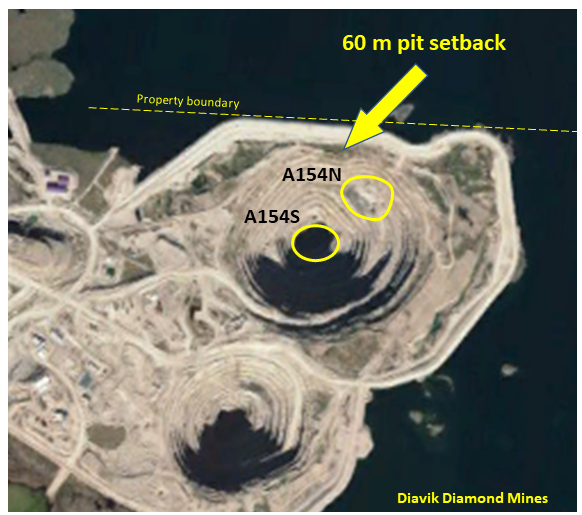 Pit wall setback: Given the size and depth of the open pit, how far must the dike be from the pit crest? Its nice to have 200 metre setback distance, but that may push the dike out into deeper water.
Pit wall setback: Given the size and depth of the open pit, how far must the dike be from the pit crest? Its nice to have 200 metre setback distance, but that may push the dike out into deeper water. Once the approximate location of the dike has been identified, the next step is to examine the design of the dike itself. Most of the issues to be considered relate to the geotechnical site conditions.
Once the approximate location of the dike has been identified, the next step is to examine the design of the dike itself. Most of the issues to be considered relate to the geotechnical site conditions. Each mine site is different, and that is what makes mining into water bodies a unique challenge. However many mine operators have done this successfully using various approaches to tackle the challenge.
Each mine site is different, and that is what makes mining into water bodies a unique challenge. However many mine operators have done this successfully using various approaches to tackle the challenge.
 NPV One is targeting to replace the typical Excel based cashflow model with an online cloud model. It reminds me of personal income tax software, where one simply inputs the income and expense information, and then the software takes over doing all the calculations and outputting the result.
NPV One is targeting to replace the typical Excel based cashflow model with an online cloud model. It reminds me of personal income tax software, where one simply inputs the income and expense information, and then the software takes over doing all the calculations and outputting the result. Pros
Pros Like anything, nothing is perfect and NPV may have a few issues for me.
Like anything, nothing is perfect and NPV may have a few issues for me. The NPV One software is an option for those wishing to standardize or simplify their financial modelling.
The NPV One software is an option for those wishing to standardize or simplify their financial modelling.
 We likely have all heard the statement that increasing pit wall angles will result in significant cost savings to the mining operation.
We likely have all heard the statement that increasing pit wall angles will result in significant cost savings to the mining operation. The results of applying the increased inter-ramp angle to each of the four pits is shown in the Bar Chart. Note that the waste reduction is not necessarily the same for each pit. It depends on the specific topography around each pit.
The results of applying the increased inter-ramp angle to each of the four pits is shown in the Bar Chart. Note that the waste reduction is not necessarily the same for each pit. It depends on the specific topography around each pit. In general one can typically see four positive outcomes from adopting steeper pit walls. They are as follows:
In general one can typically see four positive outcomes from adopting steeper pit walls. They are as follows: 4. Pit Crest Location: The steeper wall angles result in a shift in the final pit crest location. The Image shows the impact that the 5 degree steepening had on the crest location for one of the pits in this scenario.
4. Pit Crest Location: The steeper wall angles result in a shift in the final pit crest location. The Image shows the impact that the 5 degree steepening had on the crest location for one of the pits in this scenario. It is relatively easy to justify spending additional time and money on proper geotechnical investigations and geotechnical monitoring given the potential slope steepening benefits.
It is relatively easy to justify spending additional time and money on proper geotechnical investigations and geotechnical monitoring given the potential slope steepening benefits.

 I remember in the late fall of that year, the company had a chance to bid on a larger project in Gros Morne National Park, Newfoundland. So our President, Frank Nolan (he was a brother to Fred Nolan, the infamous land-owner at Oak Island, by the way), decided he wanted to see the site and he chartered a Bell 106 helicopter to fly us there from Deer Lake. It was December (they say “December month” in that province) and when we got close to the Park, we ran into a sudden snow squall.
I remember in the late fall of that year, the company had a chance to bid on a larger project in Gros Morne National Park, Newfoundland. So our President, Frank Nolan (he was a brother to Fred Nolan, the infamous land-owner at Oak Island, by the way), decided he wanted to see the site and he chartered a Bell 106 helicopter to fly us there from Deer Lake. It was December (they say “December month” in that province) and when we got close to the Park, we ran into a sudden snow squall. The QMM field office In Port Dauphin, Madagascar was located near the edge of town, and I typically walked from my lodging to the office each morning when I was there, about the time when school started for the children. Typically I passed dozens and dozens of tiny bamboo huts with corrugated metal roofs, and dirt floors each about 2 meters square.
The QMM field office In Port Dauphin, Madagascar was located near the edge of town, and I typically walked from my lodging to the office each morning when I was there, about the time when school started for the children. Typically I passed dozens and dozens of tiny bamboo huts with corrugated metal roofs, and dirt floors each about 2 meters square. It is one thing to briefly visit a remote project as part of a review team. It is another thing to be there as part of a design team trying to solve a problem and engineer a solution. I know of many engineers and geologists that would have similar work life experiences as part of their careers. However John has taken the initiative to write it all down.
It is one thing to briefly visit a remote project as part of a review team. It is another thing to be there as part of a design team trying to solve a problem and engineer a solution. I know of many engineers and geologists that would have similar work life experiences as part of their careers. However John has taken the initiative to write it all down.
 In today’s world, it is an onerous task to permit, finance, build, and operate a new mine. This is a significant achievement.
In today’s world, it is an onerous task to permit, finance, build, and operate a new mine. This is a significant achievement.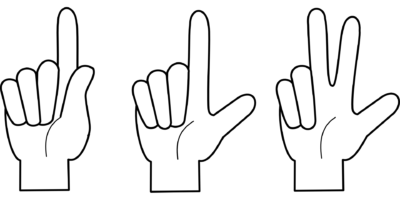 I would suggest that the three reporting categories be used instead of two, described as follows:
I would suggest that the three reporting categories be used instead of two, described as follows:
 The DRX Drill Hole and Reporting algorithm developed by
The DRX Drill Hole and Reporting algorithm developed by 
